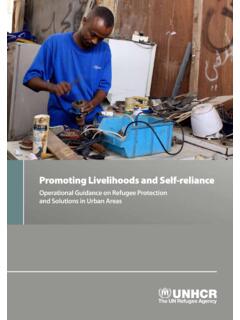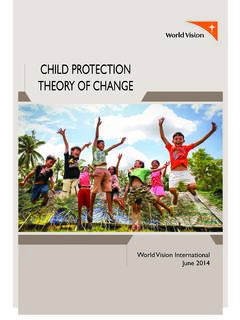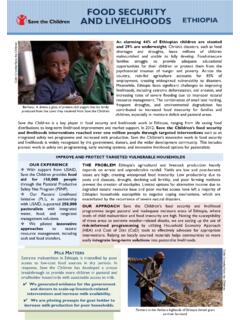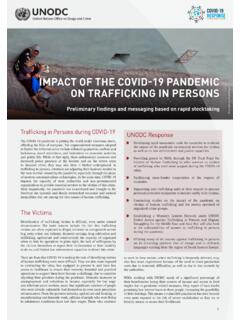Transcription of The impact of COVID-19 on indigenous communities
1 The impact of COVID-19 on indigenous communities :Insights from the indigenous NavigatorOCTOBER 2020 INDIGENOUSNAVIGATOR The traditional livelihood of indigenous peoples has been severely impacted by COVID, because they cannot go out to continue the gathering of non-timber forest products, but also during the quarantine illegal loggers have been taking advantage of extracting the resources of indigenous peoples in their community (INTERVIEW 10).Families receive relief goods assistance with hygiene kits and vegetables seeds from the initiative of Timuay Justice and Governance in partnership with Tebtebba, in the Philippines. CREDIT: TEBTEBBATHE impact OF COVID-19 ON indigenous communities : Insights from the indigenous Navigator3 AcknowledgementsThe report relies on data and information collected and shared by indigenous communities in 11 countries that have participated in the indigenous Navigator initiative, which benefits from the support of the European Union.
2 The report was written by Gabriela Balvedi Pimentel and Maria Victoria Cabrera Ormaza, from the Gender, Equality and Diversity & ILOAIDS Branch of the International Labour Organization, and Pedro Cayul, a consultant to the indigenous Navigator project. The report includes contributions and feedback from the indigenous Navigator consortium partners and local partner organizations in the 11 countries, as well as the indigenous Peoples Major Group. The views expressed in the report do not necessarily reflect the views of the European photograph: indigenous women work at field in Bangladesh during the COVID-19 pandemic. Credit ILOE ditor: Nick HenninDesign & layout: CIP DATAT itle: The impact of COVID-19 on indigenous communities : Insights from the indigenous NavigatorPublishers: The International Work Group for indigenous Affairs (IWGIA) and the International Labour Organization (ILO)Number of pages: 52 Language: EnglishGeographical area: Africa, Asia and Latin AmericaDate of publication: October 2020 ISBN: 978-87-93961-12-8 The reproduction and distribution of information contained in this report is welcome for non-commercial purposes and as long as the source is cited.
3 The reproduction of the full report without the consent of IWGIA and ILO is however not allowed. The International Work Group for indigenous Affairs (IWGIA) and the International Labour Organization (ILO), 2020 All Rights ReservedFundedby theEuropeanUnionINDIGENOUSNAVIGATORTHE impact OF COVID-19 ON indigenous communities : Insights from the indigenous Navigator4 CONTENTSACKNOWLEDGEMENTS 3 LIST OF ACRONYMS 5 LIST OF FIGURES 6 LIST OF TABLES 6 EXECUTIVE SUMMARY 71. THE indigenous NAVIGATOR: A USEFUL TOOL AT THE TIME OF THE COVID-19 CRISIS 8 2. USING indigenous NAVIGATOR DATA 10 Indicators 10 Coverage 11 Data 13 Limitations and contributors 143. PRE-EXISTING INEQUALITIES IDENTIFIED 16 Employment and working conditions 16 Social protection 21 Access to education 21 Access to health 25 Food and land security 274.
4 indigenous communities TRANSFORMED BY THE PANDEMIC: LIVE STORIES FROM THE NAVIGATOR 32 An initial diagnosis 32 indigenous peoples resilience 405. BUILDING INCLUSIVE COVID-19 RESPONSES WITH indigenous PEOPLES: A RIGHTS-BASED APPROACH 42 Establishing institutions to tackle the COVID-19 crisis with indigenous peoples 42 Strengthening protection of land possession 43 Employment and support for traditional livelihoods 43 Involving indigenous communities in controlling transmission of COVID-19 44 Overcoming barriers to education faced by indigenous peoples during the pandemic 44 CONCLUSION AND RECOMMENDATIONS 46 BIBLIOGRAPHY 48 ANNEX I 50 ANNEX II 51 THE impact OF COVID-19 ON indigenous communities : Insights from the indigenous Navigator5 LIST OF ACRONYMSAIPP Asia indigenous Peoples PactALAPA Association for Law and Advocacy for PastoralistsCAT Convention against TortureCECOIN Centro de Cooperaci n al Ind genaCEDAW Convention on the Elimination of All Forms of Discrimination against WomenCEJIS Centro de Estudios Jur dicos e Investigaci n SocialCERD Committee on the Elimination of Racial DiscriminationCHT Chittagong Hill Tracts CIPO Cambodia indigenous Peoples OrganizationCOICA Coordinator of indigenous Organizations of the Amazon River BasinCRC Convention on the Rights of the ChildDIHR Danish Institute for Human RightsFAO Food and Agriculture OrganizationFPP Forest Peoples ProgrammeICCPR International Covenant on Civil and
5 Political RightsICERD nternational Convention on the Elimination of All Forms of Racial DiscriminationICESCR International Covenant on Economic, Social and Cultural RightsILEPA indigenous livelihoods Enhancement PartnersILO International Labour OrganizationIWGIA International Work Group for indigenous AffairsLAHURNIP Lawyers Association for Human Rights of Nepalese indigenous PeoplesMPIDO Mainyoito Pastoralists Integrated Development OrganizationNGO Non-Governmental OrganizationOHCHR Office of the United Nations High Commissioner for Human RightsONAMIAP Organizaci n Nacional de Mujeres Ind genas Andinas y Amaz nicas del Per ONIC Organizaci n Nacional Ind gena de ColombiaPAHO Pan American Health OrganizationPINGO s Pastoralists indigenous Non-Governmental Organization s ForumForumSDGs Sustainable Development GoalsTebtebba indigenous Peoples International Centre for
6 Policy Research and EducationVIDS Vereniging van Inheemse Dorpshoofden in SurinameUN United NationsUNDESA United Nations Department of Economic and Social AffairsUNESCO United Nations Educational, Scientific and Cultural OrganizationUNDRIP United Nations Declaration on the Rights of indigenous PeoplesUNICEF United Nations Children s FundWFP World Food ProgrammeWHO World Health OrganizationTHE impact OF COVID-19 ON indigenous communities : Insights from the indigenous Navigator6 LIST OF FIGURESFIGURE 1. Number of community surveys 11 FIGURE 2. indigenous population employed in formal sector 17 FIGURE 3. Population that migrated in search of work 17 FIGURE 4. Men considered poor 19 FIGURE 5. Women considered poor 19 FIGURE 6.
7 Population covered by social protection programmes 21 FIGURE 7. Percentage of completed primary schooling 22 FIGURE 8. Percentage of completed secondary schooling 23 FIGURE 9. Access to internet at home 24 FIGURE 10. Title deeds in the community 28 FIGURE 11. Percentage of population with title deeds 29 FIGURE 12. Children suffering from stunting 31 LIST OF TABLESTABLE 1. Coverage by questionnaire 12 TABLE 2. indigenous population covered by the community surveys 12 TABLE 3. Method used for data collection. Percentage of communities by country 13 TABLE 4. Characteristics of men considered poor 20 TABLE 5. Characteristics of women considered poor 20 TABLE 6. How accessible are primary school facilities for children of your community?
8 22 TABLE 7. Access to facilities at school. Percentage of communities by country 25 TABLE 8. How accessible are health facilities for your community? 26 TABLE 9. Do your indigenous institutions manage health programmes? 27 TABLE 10. Right to lands, territories and resources recognized by the government 28 TABLE 11. Importance of food not produced in community 29 TABLE 12. Importance of food not produced in community 30 THE impact OF COVID-19 ON indigenous communities : Insights from the indigenous Navigator7 EXECUTIVE SUMMARYOn the basis of a collaborative, community-led data-gathering effort and testimonies from indigenous communities , this report provides first-hand information on the situation of indigenous peoples in 11 countries where communities have participated in the indigenous Navigator initiative.
9 It highlights the differentiated impact that COVID-19 is having on indigenous peoples, which also varies from community to community. On the one hand, the report identifies how pre-existing barriers in access to health, social security and education are fuelling disproportional impacts of the pandemic on indigenous peoples. It also indicates a rise in food insecurity, related to loss of livelihoods and lack of access to land and natural resources. On the other hand, it underlines the central role played by communities in building the response and recovery to the global crisis resulting from the pandemic. The analysis and recommendations presented in this report seek to contribute to the design of COVID-19 response and recovery measures that are respectful of the rights of indigenous peoples and support their livelihoods , economies and resilience.
10 Firstly, efforts should be increased to provide indigenous communities with the necessary means of prevention in relation to COVID-19 , including preventive mechanisms, access to adequately equipped and culturally appropriate healthcare facilities, and information in indigenous languages. Secondly, inclusive and community-based assessments of risks and needs should be undertaken in order to understand the specific situation of indigenous peoples. State institutions in charge of indigenous issues should be strengthened, including mechanisms for the participation of, and consultation with, indigenous peoples. indigenous peoples participation in the management of health and educational services, including the return to school, should also be ensured and distance learning opportunities provided.
















